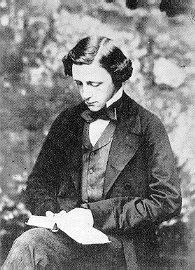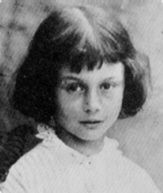The Beginning:
1832 to July 1862
 Charles
Lutwidge Dodgson (better known to many by his pen-name, Lewis Carroll)
was born on January 27th 1832 at the parsonage (photographed at right)
at Daresbury in Cheshire. He was the eldest son and third child (out of
eleven) of an Anglican clergyman Charles and Frances Dodgson (nee
Lutwidge). Charles
Lutwidge Dodgson (better known to many by his pen-name, Lewis Carroll)
was born on January 27th 1832 at the parsonage (photographed at right)
at Daresbury in Cheshire. He was the eldest son and third child (out of
eleven) of an Anglican clergyman Charles and Frances Dodgson (nee
Lutwidge).
Charles was eleven when his family moved to Croft in
North Yorkshire and, at the age of twelve, was sent to Richmond School
as a border. He was taught at Richmond by James Tate who formed a good
idea of Charles' potential, especially in mathematics.
On the 27th of January 1846 Charles was enrolled at
Rugby and stayed for three years. It was during this time that he
devised ways to entertain his brothers and sisters, in the form of
magazines containing poems, stories and drawings. These magazines
included "Useful and Instructive Poetry" (five issues), "The Rectory
Magazine" (nine issues), and "The Rectory Umbrella".
Charles matriculated at Christ Church, Oxford, in
1850. For the next five years he worked steadily until he attained a
college Mastership (in October 1855). During these five years Dodgson
continued to write and compiled a scrapbook of his best writings, called
"Mischmasch". "Mischmasch" included a four line verse, entitled "Stanza
of Anglo-Saxon Poetry", that was to become the first verse of his later
nonsense poem "Jabberwocky".
 In 1855 two
important events took place that had a profound effect on the rest of
Dodgson's life. Henry Liddell arrived as the new Dean at Christ Church
and Dodgson was introduced to photography and the Liddell children. In 1855 two
important events took place that had a profound effect on the rest of
Dodgson's life. Henry Liddell arrived as the new Dean at Christ Church
and Dodgson was introduced to photography and the Liddell children.
Liddell had previously been headmaster at Westminster
School and was well known for his book "A Greek-English Lexicon". He had
a son, Harry, and three daughters: Lorina Charlotte, Alice, and Edith.
Dodgeson first came into contact with the Liddell family in August 1855
through the Dean's niece, Fredrika Liddell. Dodgson was charmed by the
little girl and within a couple of days had sketched her.
He first met the Dean and the rest of his family in
February 1856 during a train trip to the Oxford boat races. Two months
later, during a photographic session in the Deanery garden, he properly
met Alice and the other Liddell children.
Dodgson had first become interested in photography
through his friend Reginald Southey and his own uncle, Skeffington,
during the summer vacation of 1855. He went to London in March 1856 and
purchased his own camera. The picture above, of Dodgson aged about 25,
is attributed to Southey. |
 Dodgson formed a strong friendship
with the Liddell children and was a frequent visitor to the Deanery in
order to take their pictures. The picture on the right is of Alice
Liddell, taken by Dodgson. By the latter part of 1856 Mrs Liddell had
asked Dodgson not to take any more photographs and he took this as a
hint that he was intruding too much. Fortunately the Liddells took their
winter vacation abroad and left the children in the care of their
governess, Miss Prickett. The governess let Dodgson visit the children
as often as he liked and he continued to do so after the parents
returned. He started taking the children on boating trips on the Thames
during the summer months. Dodgson formed a strong friendship
with the Liddell children and was a frequent visitor to the Deanery in
order to take their pictures. The picture on the right is of Alice
Liddell, taken by Dodgson. By the latter part of 1856 Mrs Liddell had
asked Dodgson not to take any more photographs and he took this as a
hint that he was intruding too much. Fortunately the Liddells took their
winter vacation abroad and left the children in the care of their
governess, Miss Prickett. The governess let Dodgson visit the children
as often as he liked and he continued to do so after the parents
returned. He started taking the children on boating trips on the Thames
during the summer months.
Starting in 1858 Dodgson prepared himself for Holy
Orders, attending Cuddleston Theological College until his ordaination
as a deacon in December 1861. Dodgson intended to become a priest but
never persued the theological road further. Certainly, his career as a
logician had something to do with this. He wrote of one sermon that the
preacher had 'advanced the astonishing argument "We believe that the
Bible is true, because our Holy Mother, the Church, tells us it is." I
pity the unfortunate clergyman, if he is ever bold enough to enter any
Young Men's Debating Club.'
During this period he also continued his academic and
writing career. In 1860 Dodgson published his first two mathematical
textbooks and, by February 1861, had completed another and started work
on four more. He also contributed to the magazine "The Train", signing
himself "BB". Edmund Yates, the editor, asked Dodgson for a full
pseudonym. Dodgson sent him four to choose from: Edgar Cuthwellis, Edgar
U. C. Westhall, Louis Carroll, and Lewis Carroll. Yates chose the last
of these, which Dodgson had derived by Latinizing and reversing his own
christian names: Lutwidge = Ludovicus = Lewis; Charles = Carolus =
Carroll. He first used this name as the author of a poem about Florence
Nightingale, "Solitude".
 Dodgson's
photography opened up other avenues for him. In 1857, while at Croft, he
photographed the niece of Tennyson's wife, Agnes Grace Weld (shown on
the right). The great poet called one of the portraits of the girl,
dressed as Little Red Riding Hood, "a gem" and this comment encouraged
Dodgson to seek out Tennyson at Trent Lodge, near Consiton in the Lake
District. In May 1859 and in April 1862 Dodgson stayed at Freshwater on
the Isle of Wight where Tennyson lived. During the first visit Dodgson
managed to get Tennyson to sit for a photographic session. On the second
visit Tennyson was too busy, but Dodgson photographed his sons,
Hallam and Lionel. Dodgson's
photography opened up other avenues for him. In 1857, while at Croft, he
photographed the niece of Tennyson's wife, Agnes Grace Weld (shown on
the right). The great poet called one of the portraits of the girl,
dressed as Little Red Riding Hood, "a gem" and this comment encouraged
Dodgson to seek out Tennyson at Trent Lodge, near Consiton in the Lake
District. In May 1859 and in April 1862 Dodgson stayed at Freshwater on
the Isle of Wight where Tennyson lived. During the first visit Dodgson
managed to get Tennyson to sit for a photographic session. On the second
visit Tennyson was too busy, but Dodgson photographed his sons,
Hallam and Lionel.
Copyright 1995,96, Cameron
Newham
Lewis Carroll website
Louis Carroll was one
of the four options of pseudonym offered by Charles
Lutwidge Dodgson, but all were passed over in favour of Lewis Carroll.
David Melville, Philosophy of Rotary project |

